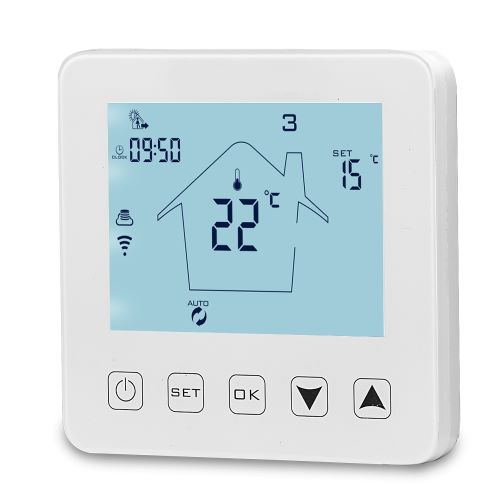Underfloor heating for bedrooms
There are several reasons why underfloor heating is so popular in bedrooms. Underfloor heating provides a consistent and even warmth across the entire floor, which can create a comfortable and cosy atmosphere in your bedroom. You won't experience cold spots or drafts, making it especially appealing during the winter months. Secondly, unlike radiators which use convectional heating that can circulate allergens and dust, underfloor heating produces gentle radiant heat which can be beneficial for individuals with allergies or respiratory issues.
This page has some important things to consider when planning the installation of underfloor heating in your bedroom as well as giving you information on whether electric underfloor heating mat kits or warm water underfloor heating pipes would be the best fit for your project.

Electric Vs Wet underfloor Heating – Which is most popular for a bedroom?
In new builds, wet underfloor heating tend to be more popular while in retrofits and extensions, electric underfloor heating tends to be more commonly installed.
Ease of Install: Electric underfloor heating systems are easier and quicker to install compared to wet systems. They consist of electric heating cables or mats that are installed directly beneath the flooring. In contrast, wet systems require laying pipes with the subfloor which can be more complex and time-consuming unless the subfloor is new.
Cost-effectiveness: An electric underfloor heating kit for an average bedroom will be much cheaper than a wet kit with a separate manifold.
Floor Height: A electric heating mat is only a few millimetres think and will not raise the floor height by much. Wet underfloor heating will cause much larger increase in floor height unless you install them between the joists of a suspended floor or within a new floor
Manifold: All wet systems need a manifold which take up space and are often not practical for a single room. If you are fitting underfloor heating in a new build you can dedicate a large cupboard for the manifold.

What floor covering is best in a bedroom with electric underfloor heating?
The most common floor coverings for Bedroom are carpet, wooden laminate and engineered wood however it is becoming more popular to have Vinyl or tiles in the bedroom when paired with underfloor heating for that warm underfoot feeling when you first get out of bed.
Carpet
Pro’s: Easy to install on pretty much any subfloor, minimal increase in floor height
Con’s: Need to make sure that tog rating of carpet and underlay is 2.5 or less.
It is easy to fit electric underfloor heating under carpet. First you put a 6mm batten going around the perimeter of the room. You put then place the 6mm Depron “Protect” Board on floor and the underfloor heating is stuck on top. The underlay and carpet simply lay on top of the heating mats.
Thickness:
Matting: Approx 8mm (matting and 6mm insulation)
Insulation: Mostly loose laid but the board on the perimeter should be stuck down with double sided tape.
Laminate and Engineered wood
Pro’s: easy to fit, minimal increase in floor height, no need for any tile adhesives or self-levelling compounds.
Con’s: None
Fitting electric underfloor heating under laminate and engineered wood is often the easiest option for bedrooms. The system is quite flexible and therefore can fitted straight ontop of most concrete or wooden subfloors without the need for further strengthening.
Thickness: Approximately 8mm (matting and 6mm insulation)
Tiles
Pro’s: Heats up quickly, easy to clean
Con’s: Need a stable subfloor so that the tiles & Grout don’t crack
It is easy to fit electric underfloor heating under tiles. You just need to make sure that the subfloor (particularly if it’s wooden joists) is stable enough for tiling so that no cracks appear. The matting is typically covered with a self-levelling compound so that you can get a good finish on your tiles.
Thickness:
Matting: Approx 5mm (mat with self-levelling compound)
Insulation (Stuck down): Approx 6mm for the insulation and 4mm for adhesive
Insulation (screwed down): 6mm Ultra Tile backer board
Vinyl, LVT, Amtico or Karndean
Pro’s: Easy to clean, attractive designs of flooring
Con’s: Need a stable subfloor, Matting needs to be covered by minimum 14mm of self-levelling compound so floor height often a problem.
Although fitting electric underfloor under vinyl type flooring is very popular it is the method that requires the most floor height. This is because the matting needs to be covered by a minimum of 14mm of self-levelling compound and sometimes even more. This makes the overall installation cost more expensive than tiles or a wood laminate.
Thickness: 14mm – 25mm thickness for the heating mat within a self-levelling compound

Where should I fit the underfloor heating thermostat?
The electric underfloor heating thermostat should be installed within the bedroom, at light switch height. Importantly, it should not be near any other heat sources (e.g radiators). It’s also best top avoid drafts if possible. Ideally, mount the thermostat on an interior wall as exterior walls are more susceptible to temperature variations. The best location is somewhere out of the way and which is the average temperature of the room.
Never program to the thermostat to have the underfloor heating on when not required to help reduce running costs.
CLICK HERE TO SEE OUR RANGE OF ELECTRIC UNDERFLOOR HEATING
CLICK HERE TO SEE OUR RANGE OF WATER UNDERFLOOR HEATING




